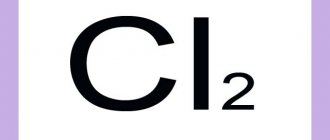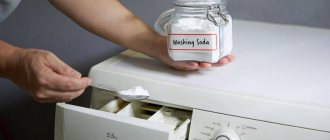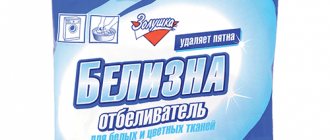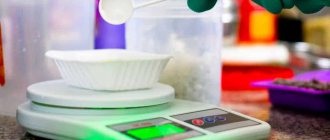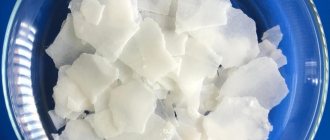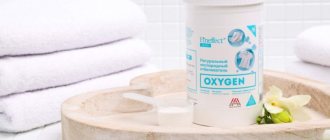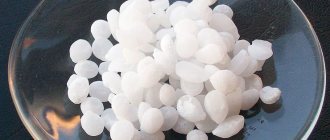Today, as many years ago, the leader in disinfection is chlorine-containing products and bleach in particular. It is widely used in various fields. These affordable products effectively deal with all kinds of pathogens. But the scope of application of chloroactive compounds is not limited solely to disinfection. How to use it correctly and where to buy bleach for disinfection - more on that later.
Chlorine-containing disinfectants
Most often, bleach is used for disinfection , or, as this product is commonly called, bleach. The composition of the product is a mixture of various potassium compounds: hypochlorite, hydroxide and chloride. This is a caustic powder product that is white in color and has a characteristic pungent aroma of chlorine. It is quite active and toxic, and therefore requires special storage conditions and careful use.
The chlorine content in the mixture ranges from 28 to 35%. The product is unstable and gradually decomposes under normal conditions. The content of the active component - chlorine - decreases over time, and the mixture “fizzles out”. When its concentration decreases to 15%, the product loses its disinfectant properties.
Bleach can be used in its original powder form. It processes all kinds of waste, including biological waste, places of their storage and disposal. A special point in using a dry product is the mandatory pre-moistening of the surfaces. A completely waterless treatment will not produce results. Much more often bleach is used in the form of solutions of varying concentrations. Sometimes it is still included in whitewash and putty. That’s why bleach is also called bleach. The product is also used in tablet form.
In addition to bleach, bleach also refers to sodium hypochlorite - the most popular bleaching and disinfectant among all chlorine-containing products. Its share in the world market exceeds 90%. It is the basis of such well-known household products as whiteness, tiret, domestos, clorox, ac, etc. You can also find many similar products on sale, which will have different trade names. For example, Chloramine, Antiseptol, Des-chlor, Newzhavel, Deo-chlor, etc.
For disinfection, bleach can be replaced with chloramine. This compound has the same disinfecting properties, but a less pronounced chlorine odor. It is used in the form of ordinary and enhanced solutions. The latter are obtained by introducing ammonia additives into the composition.
Complex mixture
In its pure form, chlorine is a toxic gas that is classified as a chemical warfare agent. In high doses, it can cause chemical burns and damage the respiratory system.
But under normal conditions, it is very difficult to be poisoned by chlorine compounds, if we are talking about household chemicals, and not in situations related to the industrial production of chemicals, Roman Khryapin, a biologist at the Moscow City Disinfection Center, told Izvestia.
— Recommendations to take basic precautions—use a mask and gloves, read the instructions carefully—are sound, they are given for a reason. But it is very difficult to become poisoned by chlorine, which is part of disinfectants, so much that you need to call a doctor. This requires a very large dosage, it’s difficult not to notice it,” he believes.
For an adult who does not have diseases associated with increased risks (for example, allergies, skin diseases, respiratory diseases), it is enough to follow the usual precautions. And even if some symptoms of poisoning appear, they will not cause serious harm to health and will disappear after a few hours. This may include redness of the hands, watery eyes, or a sore throat, which may not require a visit to the doctor.
Photo: Depositphotos
Alcohol activities: they want to make antiseptics from confiscated alcohol
The Federation Council proposed temporarily abandoning the destruction of illegal drinks
At the same time, such compositions are much more dangerous than modern household chemicals. Therefore, those who do professional cleaning have practically abandoned their use, Ivan Golubtsov, executive director of the Union of Cleaning Companies of Russia, explained to Izvestia.
The main risk, in his opinion, may lie in the combination of such products with others - which consumers may not be aware of.
— Firstly, the chlorine in their composition leads to the fact that they degrease your hands quite strongly, which is why their careless use can lead to “chemical” burns. In addition, such products can be dangerous when mixed with others. If you use our classic, inexpensive chlorine-containing products that everyone knows and loves, say, on a toilet, and then add a specialized acidic toilet cleaner that everyone also uses, you can get a pretty strong chlorine release. In the presence of acid, the household product will begin to emit pure chlorine, which, as is known, is a poisonous gas, says the publication’s interlocutor.
At the chlorine reception: demand for disinfection has increased by 100%
Due to the threat of coronavirus, people are willing to pay up to 10 thousand rubles for cleaning
If poisoning does occur, it can be either acute or chronic, with a cumulative effect. This occurs after several weeks of improper use of the product. It is possible that this is exactly what is now observed in the Sverdlovsk region, believes Ivan Golubtsov.
Areas of application of bleach
Chlorine-containing products are multifunctional . For many years they have been used for the following purposes:
- disinfection of medical instruments, equipment, premises;
- decontamination of biological media (feces, blood, vomit, urine) and food waste in hospitals;
- sanitation in preschool institutions, schools;
- sanitization of cages, vehicles, premises related to poultry and livestock farming;
- bleaching pulp and fabrics;
- wastewater treatment;
- chlorination of tap and well water, as well as swimming pools;
- production of household chemicals, pesticides, medications;
- other industries, including food.
At recommended doses
Rospotrebnadzor itself recommended using products containing chlorine to disinfect housing in early April. Then the federal department published a list of 12 points.
“Wash with soap or treat with an alcohol-based antiseptic of at least 70% or a chlorine-containing solution. You need to wash those hands that you touch when you come home, before you wash your hands with soap. After cleaning door handles, be sure to wash your hands with soap,” the first paragraph said.
In addition, the department drew attention to the need to treat switches with an antiseptic wipe if a person with coronavirus lives in the room. During cleaning, it was also suggested to wash cabinet handles with soap, wipe the backs of chairs not upholstered with soft material, wipe the surfaces of desks, coffee tables, kitchen countertops and household appliances.
Photo: Depositphotos
It is recommended to additionally treat toiletries, including toothbrushes, with an antiseptic. It was proposed to wash the sink with household chemicals, which were then thoroughly rinsed with water; the bathtub and toilet should be cleaned using chlorine-containing products.
If there is a person with coronavirus infection in the house, it is recommended to repeat the procedure after each use. At the same time, the recommendations emphasize that, first of all, it is recommended to use chlorine-based products in a house where there is a patient. In other cases, regular cleaning using ordinary household chemicals is sufficient.
“We use medical alcohol instead of antiseptic”
Beauty salon owners and craftsmen talk about working during an epidemic
Instructions for use of sodium hypochlorite
Aqueous unsaturated solutions are used to disinfect non-metallic objects and various surfaces. Their concentration is usually 0.2−10%. Given the aggressiveness of the product, it is not used for treating clothing and metal tools that are not protected from corrosion. You also need to take into account the instability of powdered hypochlorite. Therefore, it must be stored in a darkened non-residential area , where the temperature is low and the required level of ventilation is maintained, tightly packed. Access of air and moisture directly to hypochlorite is unacceptable.
For disinfection, first prepare the initial solution by mixing dry powder with water (at the rate of 200 g per 1 l). The mixture is kneaded and left to infuse. Afterwards, the resulting liquid is carefully drained without shaking the sediment. The stock solution of 10% concentration is ready. It can be stored in a tightly sealed container in cool and dark conditions for 5-7 days without the risk of loss of beneficial properties.
Based on the resulting solution, disinfectant liquids of the required concentration are prepared. To do this, the original composition must be diluted with water. The required saturation is calculated using the formula
A 1000/s,
where, A is the required concentration of the solution;
c is the concentration of the initial solution (in our case, 10%).
Let's say you need to prepare a 0.5% product.
0,5×1000/10=50
According to calculations, you need to take 50 ml of the original 10% solution and dilute it with water to a liter volume.
Recommended solution concentrations:
- for cleaning in the presence of the patient - 0.125%;
- for inventory - 0.2−0.5%;
- for treating floors, walls, doors, furniture - 1%;
- for cleaning products - 2%;
- for disinfecting bathrooms - 5%;
- for cleaning street toilets, cesspools - up to 10%.
The resulting liquid is applied by spraying, wiping or washing the required area or objects. For soaking dishes, linen, and cleaning materials, it is permissible to use a 0.2−2% aqueous solution of sodium hypochlorite. If waste treatment is necessary, they are mixed with the powder product without prior dissolution in a 1:1 ratio. After disinfection, the dishes must be thoroughly rinsed, the laundry washed, and the room ventilated.
Cautions and usage details
In order to avoid negative consequences, when coming into contact with bleach, you should follow a number of rules . Here are the main ones:
- Persons under 18 years of age, as well as pregnant women, are prohibited from working with the drug.
- Before starting treatment, it is advisable to remove people and animals from the premises.
- It is necessary to protect the skin and mucous surfaces from the action of bleach. For this purpose, hands are covered with rubber gloves, respiratory organs are covered with a bandage, and eyes are covered with protective goggles. It is recommended to use a rubberized apron.
- After treatment, high-quality ventilation of the room is required.
- The storage conditions of both starting substances and finished solutions must not be violated.
- If the product gets on open areas of the body or mucous membranes, the affected area should be thoroughly rinsed with water. If accidentally swallowed, induce vomiting.
- If signs of chlorine vapor poisoning appear, you should immediately remove the victim to air and call an ambulance. Alarming symptoms: dizziness, nausea, taste of chlorine even in the absence of fumes, shortness of breath, soreness, lacrimation, pain in the peritoneum, vomiting.
Asthmatics and children
Against the backdrop of the coronavirus pandemic, people have begun to increasingly use chlorine-containing products to disinfect apartments, while failure to comply with the rules for their use leads to poisoning. The fact that such cases have become more frequent in the city was reported on Monday, May 11, on the official portal of Yekaterinburg. The authors refer to data from the city department of Rospotrebnadzor.
It is not specified how significant the increase was compared to previous periods, but the website says that they have begun to occur more often. In the first quarter of 2022, such cases accounted for 6.8% of the total number of poisonings, with half of the cases involving children under 14 years of age. 60% of them were injured due to the negligence of adults.
Photo: Global Look Press/Monika Skolimowska/dpa-Zentralbild/dpa
“To prevent this from happening, you must remember: chlorine is a poisonous gas that irritates the mucous membranes of the eyes and respiratory tract. Fumes contained in cleaning products with high chlorine content can cause lung irritation, which is especially dangerous for children and people with heart problems or suffering from respiratory diseases such as asthma or emphysema,” the city hall’s website emphasizes.
Purely for health: the demand for housekeepers has sharply increased in Russia
Isolated citizens began to call domestic staff more often
Izvestia was unable to find this data on the department’s regional website, but information with reference to the regional department of Rospotrebnadzor was also distributed by a number of regional media outlets, including Kommersant-Ural.
Where to buy disinfectants
Disinfectants with chlorine are quite cheap and in demand. Therefore, problems with their acquisition never arise. You can buy bleach or its derivatives at pharmacies, hardware stores, or the household goods section of the supermarket. The widest selection of such products is presented on the pages of online stores. Possible options for disinfectants with active chlorine for purchase wholesale and retail:
- Bleach - bags (20 kg) or steel drums.
- Sodium hypochlorite - 20 l canisters.
- Chloramine - packages from 250 g.
- Products in tablets and granules - pack of 300 tablets. or 1 kg.
- Detergents, cleaners and bleaches with chlorine - packaging from 1 liter (1 kg).
The content of active chlorine in them may vary. Therefore, when preparing solutions, you must strictly follow the instructions included with the product. Each buyer makes his own decision about which product option is better. It depends on the goals pursued and personal preferences. All chlorine-containing products, when used correctly and in compliance with the recommended concentrations, are quite effective.
Why is chlorine added to detergents?
We have all been familiar with the smell of chlorine since childhood, when schools, hospitals, swimming pools and other institutions used cheap liquid with a chemical concentrate during cleaning. Many people still associate this persistent and pungent smell with cleanliness and disinfection.
Today, chlorine is still an essential ingredient in inexpensive cleaning products. It is found in bleach, toilet cleaners, sink and bathtub cleaning gels, multi-surface cleaners, mildew-killing liquids, and even dishwasher cleaning tablets. Manufacturers thus achieve the desired effect of cleaning, whitening and disinfection. After all, these are long-known and confirmed properties of chlorine.
It can be “hidden” in household chemicals under different names: hypochlorite, sodium hypochlorite, sodium dichloroisocyanurate, methylchloroisothiazoline or hydrogen chloride. But this does not change its physical and chemical properties in any way.
META-ANALYSIS
The Invisible Threat: Toxic Substances in Your Home
ESI has initiated research and evidence gathering into what is really happening in the cleaning products industry to educate people, warn them and help protect their health.
Download, read, be healthy and enjoy life...
